Nepetoideae
| Nepetoideae | ||||||||||||
|---|---|---|---|---|---|---|---|---|---|---|---|---|

Thyme ( Thymus serpyllum ), illustration |
||||||||||||
| Systematics | ||||||||||||
|
||||||||||||
| Scientific name | ||||||||||||
| Nepetoideae | ||||||||||||
| Kostel. |
The Nepetoideae are connected 3100-3700 kinds the most diverse subfamily of the plant family of Labiatae (Lamiaceae). There are many well-known medicinal and aromatic plants such as basil , savory , lavender , mint , oregano , rosemary , sage , thyme , hyssop and lemon balm .
Description and ingredients

Vegetative characteristics
They are mostly herbaceous plants , sometimes bushes or rarely trees . Many species have an aromatic smell. The stems are often square. The opposite leaves are usually simply or rarely composed.
Generative characteristics
The hermaphrodite flowers are fünfzählig and zygomorph double perianth (perianth). The five sepals are fused. The five petals are fused, with the crown being two-lipped. There are four stamens , two of which can be reduced to staminodes . The flower formula for the species of the Nepetoideae is:
The sign "|" symbolizes the separation by additional partitions.
The trinuclear pollen grains are hexacolate. In the embryo , the base of the germ layers ( cotyledons ) is elongated, which means that the hypocotyl and the radicula are largely covered. The trinuclear pollen grains have a hexacolpate aperture.
The most important ingredients in the Nepetoideae are rosmarinic acid and volatile terpenoids . Nepetoidin A and B, low concentrations of betaines and iridoid glycosides and prismatic calcium oxalate crystals in the epidermis of the calyx are present.
Systematics and distribution


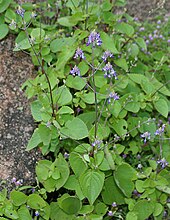










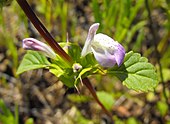
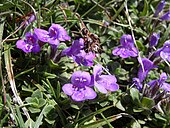
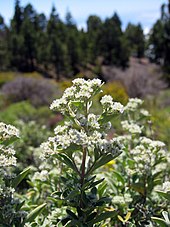

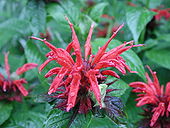



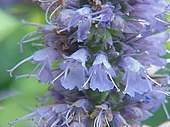


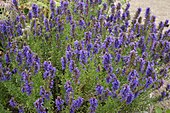
The subfamily of the Nepetoideae contains about 105 (up to 130) genera with 3600 to 3700 species. All molecular genetic investigations carried out to date confirmed that the subfamily Nepetoideae is monophyletic . The most species-rich genus is sage ( Salvia ) with around 900 species.
The subfamily of the Nepetoideae was named after Cantino et al. 1992 in the four tribes Elsholtzieae Burnett , Lavanduleae Caruel , Mentheae Dumort. and Ocimeae Dumort. structured. According to Harley & al. In 2004 there are only three tribes, because after their publication the Lavanduleae will be incorporated into the Ocimeae:
Not classified in a tribe (incertae sedis)
-
Ombrocharis Hand.-Mazz. : It contains only one type:
- Ombrocharis dulcis hand.-Mazz. : It thrives in subtropical evergreen forests at altitudes of around 1300 meters only in the Chinese province of Hunan .
Tribe Elsholtzieae
Tribus to Burnett .
This contains five to six genera:
- Horse balm ( Collinsonia L. , Syn .: Hypogon Raf. , Diallosteira Raf. , Pleuradenia Raf. , Micheliella Briq. ): The four species are distributed from eastern Canada through the north-central and eastern USA . Sometimes the Asiatic species of the genus Keiskea are Miq. contain.
- Comb mints ( Elsholtzia Willd. , Syn .: Aphanochilus Benth. , Cyclostegia Benth. , Paulseniella Briq. , Platyelasma Kitag. ) The distribution area of the approximately 40 species extends from Siberia to Central Asia , China , Mongolia and East Asia and from the Indian subcontinent to the Himalaya region and the Southeast Asian Peninsula to Malesia .
- Keiskea Miq. (sometimes in the genus Collinsonia ): The six or so species are distributed from China to Japan.
- Mosla (Benth.) Buch.-Ham. ex Maxim. (Syn .: Orthodon Benth. Nom. Illeg.): The approximately 14 species are distributed from the Caucasus to the Himalayas to the Kuriles and northern Sumatera .
-
Perilla L. (Syn .: Dentidia Lour. ): It contains only one species:
- Perilla frutescens (L.) Britton : It is distributed with three varieties from the Indian subcontinent via Primorye and Korea to Japan .
-
Perillula Maxim. : It contains only one type:
- Perillula reptans Maxim. : It occurs in Japan.
Tribe Ocimeae
Tribus to Dumort.
This contains about 44 genera. The largest genus Hyptis sl was polyphyletic and was divided into many smaller genera in 2012, all of which belong to the Subtribus Hyptidinae Endl. (up to 19 genera) include: There is also the subtribe Ociminae JASchmidt , for example .
- Aeollanthus Mart. ex explos. (Syn .: Aeolanthus Mart. Orth. Var., Bovonia Chiov. , Icomum Hua , Oxyotis Welw. Ex Baker ): The 44 or so species are distributed from tropical to southern Africa .
- Alvesia Welw. (Syn .: Plectranthastrum T.CEFr. ): The three or so species are common in tropical Central and East Africa.
- Anisochilus Wall. ex Benth. (Syn .: Stiptanthus Briq. ): The approximately 17 species are distributed from tropical Asia to China .
- Asterohyptis Epling : The only four species are distributed from Mexico to Central America and on Caribbean islands. (belongs to the subtribe hyptidinae)
-
Basilicum Moench (Syn .: Lehmannia Jacq. Ex Jacq. F. , Lumnitzera Jacq. Ex Spreng. Nom. Illeg., Moschosma Rchb. , Perxo Raf. ): It contains only one species:
- Basilicum polystachyon (L.) Moench : It is distributed from tropical to southern Africa, on islands of the western Indian Ocean , the tropics and subtropics of Asia to northern Australia .
-
Benguellia G.Taylor : It contains only one species:
- Benguellia lanceolata (Gürke) G.Taylor : It occurs in Angola.
- Cantinoa Harley & JFBPastore (before 2012 in Hyptis Jacq. And belongs to the Subtribus Hyptidinae): The approximately 26 species are common in the Neotropic.
- Capitanopsis S.Moore : The only three species are common in Madagascar .
- Catoferia ( Benth. ) Benth. (Syn .: Catopheria Benth. Orth. Var.)
- Condea Adans. (before 2012 in Hyptis Jacq. and belongs to the Subtribus Hyptidinae): The approximately 27 species are common in the Neotropic.
- Cyanocephalus (Pohl ex Benth.) Harley & JFBPastore (before 2012 in Hyptis Jacq. And belongs to the Subtribus Hyptidinae): The approximately 25 species are distributed in Cuba and from Brazil to Paraguay.
-
Dauphinea Hedge : It contains only one species:
- Dauphinea brevilabra Hedge : It occurs in southeast Madagascar.
- Endostemon N.E.Br. (Syn .: Pseudocimum Bremek. , Puntia Hedge ): The approximately 20 species are distributed from tropical to southern Africa and India.
- Eplingiella Harley & JFBPastore (before 2012 in Hyptis Jacq. And belongs to the Subtribus Hyptidinae): The only two species are common in eastern Brazil.
- Eriope Humb. & Bonpl. ex Benth. : The wide distribution area of the approximately 30 species extends in tropical South America from Colombia via Venezuela , French Guiana , Brazil and Bolivia to Paraguay . (belongs to the subtribe hyptidinae)
-
Eriopidion Harley (sometimes in Eriope Humb. & Bonpl. Ex Benth. ): (Belongs to the Subtribus Hyptidinae): It contains only one species:
- Eriopidion strictum (Benth.) Harley : It is distributed in northeastern Venezuela and northeastern Brazil.
- Fuerstia T.CEFr. : The approximately new species are common in tropical Africa.
- Gymneia (Benth.) Harley & JFBPastore (before 2012 in Hyptis Jacq. And belongs to the Subtribus Hyptidinae): The approximately five species are distributed from Brazil to Bolivia.
- Hanceola Kudô (Syn .: Hancea Hemsl. ): The eight or so species are common in China, with some species having a relatively limited range.
- Haumaniastrum P.A. Duvign. & Plancke (sometimes in Acrocephalus Benth. ): The approximately 35 species are distributed from tropical to southern Africa and Madagascar.
-
Hoslundia Vahl (Syn .: Haaslundia Schumach. & Thonn. , Micranthes Bertol. ): It contains only one species:
- Hoslundia opposita Vahl : It is distributed from tropical to southern Africa and Madagascar.
- Hypenia (Mart. Ex Benth.) Harley : The approximately 25 species are distributed from northern South America to Brazil.
- Hyptidendron Harley (Syn .: Siagonarrhen Mart. Ex JASchmidt ): The 16 or so species are common in tropical South America.
- Hyptis Jacq. (Syn .: Hypothronia Cabinet , Peltodon Pohl ) (belongs to the Subtribus Hyptidinae): The approximately 200 (previously up to 400) species are mainly found in the Neotropic and a few species are also found in tropical western to central western Africa.
- Isodon (. Schrad ex Benth.) Spach (Syn .: Amethystanthus Nakai , Dielsia Kudô nom illeg,.. Homalocheilos J.K.Morton , Rabdosia (Blume) Hassk. , Skapanthus C.Y.Wu & HWLi ): The approximately 104 species are Palaeotropical disseminated .
- Lavender ( Lavandula L. , Syn .: Fabricia Adans. , Styphonia Medik. , Chaetostachys Benth. , Sabaudia Buscal. & Muschl. , Isinia Rech. F. , Stoechas Mill. ): The approximately 36 species are from Macaronesia across the Mediterranean and common in India .
- Leptohyptis Harley & JFBPastore (before 2012 in Hyptis Jacq. And belongs to the Subtribus Hyptidinae): The approximately five species are common in eastern Brazil.
- Marsypianthes Mart. ex Benth. (belongs to the subtribe Hyptidinae): The five or so species are common in the Neotropic.
- Martianthus Harley & JFBPastore (before 2012 in Hyptis Jacq. And belongs to the Subtribus Hyptidinae): The approximately four species are distributed from northeastern Brazil to Peru.
- Medusantha Harley & JFBPastore (before 2012 in Hyptis Jacq. And belongs to the Subtribus Hyptidinae): The eight or so species are common in Brazil.
- Mesosphaerum P.Browne (before 2012 in Hyptis Jacq. And belongs to the Subtribus Hyptidinae, Syn .: Brotera Spreng. Nom. Illeg., Gnoteris Raf. Nom. Superfl., Schaueria Hassk. Nom. Illeg.): Which are about 23 species widespread in the Neotropic.
- Basil ( Ocimum L. , Syn .: Becium Lindl. , Erythrochlamys Gürke , Hyperaspis Briq. , Nautochilus Bremek. ) The approximately 60 species thrive in the subtropics to the tropics and are mainly found in temperate Africa and South America.
- Oocephalus (Benth.) Harley & JFBPastore (before 2012 in Hyptis Jacq. And belongs to the Subtribus Hyptidinae): The approximately 14 species are distributed from Brazil to Bolivia.
- Orthosiphon Benth. (Syn .: Clerodendranthus Kudô ): The 34 to 40 species are distributed from tropical to southern Africa as well as in northeastern Australia and Colombia.
-
Physominthe Harley & JFBPastore (before 2012 in Hyptis Jacq. And belongs to the Subtribus Hyptidinae): It contains only one species:
- Physominthe vitifolia (Pohl ex Benth.) Harley & JFBPastore : It is widespread in western- central and eastern Brazil.
-
Platostoma P.Beauv. (Syn .: Acrocephalus Benth. , Ceratanthus F.Muell. Ex G.Taylor , Geniosporum Wall. Ex Benth. , Hemsleia Kudô , Limniboza R.E.Fr. , Mesona Blume , Nosema Prain , Octomeron Robyns ) The wide distribution ranges from tropical to subtropical as well as southern Africa and from China via the Southeast Asian Peninsula , Malesia and Papua New Guinea to Australia.
- Platostoma palustre (flower) AJPaton
- Plectranthus ( Plectranthus L'Hér. , Syn .: Ascocarydion G.Taylor , Briquetastrum Robyns & Lebrun , Burnatastrum Briq. , Calchas P.V.Heath , Capitanya Gürke , Coleus Lour. , Dielsia Kudô non Gilg , Englerastrum Briq. , Germanea Lam. , Holostylon Robyns & Lebrun , Isodictyophorus Briq. , Leocus A.Chev. , Majana Rumph. ex Kuntze , Mitsa Chapel. ex Benth. , Neohyptis J.K.Morton , Neomuellera Briq. , Perrierastrum Guillaumin , Psythirhisma Herb. ex Lindl. nom. illeg., Rabdosiella Codd , Saccostoma Wall ex Voigt. , Solenostemon Thonn. , Symphostemon Hiern ): the about 325 species are Palaeotropical common.
- Pycnostachys Hook. (Syn .: Echinostachys E. Mey. ): The approximately 36 species are distributed from tropical to southern Africa and Madagascar.
-
Rhaphiodon Schauer (Syn .: Raphiodon Benth. Orth. Var.): It contains only one species:
- Rhaphiodon echinus (Nees & Mart.) Schauer occurs in eastern Brazil.
- Siphocranion Kudô : The only two types are distributed from the eastern Himalayas (one type) to southern China (both types).
- Syncolostemon E. Mey . (Syn .: Hemizygia (Benth.) Briq. , Bouetia A.Chev. ): The 44 or so species are distributed from the arid tropical to southern Africa, Madagascar and India.
- Tetradenia Benth. (Syn .: Iboza N.E.Br. ): About 20 species are distributed in Africa from Eritrea to southern Africa and Madagascar.
- Thorncroftia N.E.Br. : The five to six species occur in the South African provinces of Limpopo , Mpumalanga and KwaZulu-Natal and two of them also in Swaziland .
Tribe Mentheae
Tribus to Dumort . It contains about 66 genera with 2075 to 2300 species in three subtribes since 2008: Salviinae Endl. with about eight genera, Nepetinae Coss. & Germ. with 12 or 17 genera and Menthinae Endl. and since 2012 two new subtribes Lycopinae BTDrew & Sytsma with only one genus, Prunellinae (Dumort.) BTDrew & Sytsma with three genera:
- Subtribus Lycopinae BTDrew & Sytsma : It contains only one genus:
- Wolfstrapp ( Lycopus L. , formerly in the Subtribus Nepetinae): It is distributed almost worldwide with around 16 species, mainly in Eurasia and North America.
- Subtribus Prunellinae (Dumort.) BTDrew & Sytsma : It contains three genera:
-
Cleonia L. (formerly in the Subtribus Nepetinae): It contains only one species:
- Cleonia lusitanica L .: It is common on the Iberian Peninsula and in northwestern Africa.
-
Horminum L. (formerly in the Subtribus Nepetinae): It contains only one species:
- Dragon's mouth ( Horminum pyrenaicum ): It thrives in European mountains: in the Alps , the Apuan Alps and the Pyrenees .
- Brown cells ( Prunella L. , Syn .: Brunella Mill. , Prunellopsis Kudô ; formerly in the Subtribus Nepetinae): The approximately seven species to fifteen species are common in the temperate and subtropical regions of all continents of the northern hemisphere .
- Subtribe Menthinae Endl. : It contains about 44 genera with about 760 species with almost worldwide distribution; they usually thrive in temperate areas:
- Acanthomintha (A. Gray) Benth. & Hook. f. : The fouror sospecies are distributed from the US state of California to northwestern Mexico .
- Stone squid ( Acinos Mill. ) (It is sometimes associated with Clinopodium L. or Ziziphora L. ): The ten or so species are distributed from southern Europe across the Mediterranean to western Asia.
- Blephilia Raf. : The three or so species are distributed in North America from eastern Canada to the eastern and central USA.
- Bystropogon L'Hér. : Of the approximately seven species and three natural hybrids are common on the Canary Islands and Madeira .
- Mountain mint ( Clinopodium L. sl, Syn .: Acinos Mill. , Antonina Vved. , Bancroftia R.K. Porter nom. Illeg., Calamintha Mill. , Ceratominthe Briq. , × Calapodium Holub , Diodeilis Raf. , Faucibarba Dulac , Gardoquia Ruiz & Pav. , Nostelis Raf. , Oreosphacus Phil. , Rafinesquia Raf. , Rizoa Cav. , Xenopoma Willd. ): The 100 to 130 species thrive from temperate to subtropical areas to tropical mountain regions worldwide, except in Australia. Some formerly independent genera were classified here.
- Conradina A.Gray : The six or so species are common in the southeastern United States.
-
Cuminia Colla (Syn .: Johowia Epling & Looser nom. Illeg., Skottsbergiella Epling nom. Illeg.): It contains only one species:
- Cuminia eriantha Benth .: The two varieties are endemic to the Juan Fernández Islands .
- Cunila D.Royen ex L. (Syn .: Mappia Heist. Ex Fabr. Nom. Illeg., Hedyosmos Mitch. ): The approximately 16 species are distributed in the New World from the USA to Central and South America.
- Cyclotrichium Mandenova & Schengelia : The nine or so species are common in Western Asia.
- Dicerandra Benth. (Syn .: Ceranthera Elliott nom. Illeg.): The nine or so species are common in the southeastern USA.
-
Eriothymus Rchb. : It contains only one type:
- Eriothymus rubiaceus (Benth.) JASchmidt : It is widespread in southeastern Brazil.
- Glechon blast. : The six to seven species are distributed from southern Brazil via Paraguay and Uruguay to Argentina .
-
Goncharovia Boriss. : It contains only one type:
- Gontscharovia popovii (B.Fedtsch. & Gontsch.) Boriss. : It is distributed from eastern Afghanistan to the western Himalayan region.
- Hedeoma Pers. (Syn .: Pseudocunila Brade ): The 42 or so species are common in the New World.
- Hesperozygis Epling : The seven or so species are common in Mexico and Brazil.
- Hoehnea Epling (Syn .: Keithia Benth. Nom. Illeg.): The four or so species are common in Brazil, Paraguay and Argentina.
- Killickia Bräuchler, Heubl & Doroszenko : The three to four species occur only in the South African province of KwaZulu-Natal .
-
Kurzamra Kuntze : It contains only one species:
- Short amra pulchella (Clos) Kuntze : It is common in Chile and Argentina.
- Mints ( Mentha L. , Syn .: Pulegium Mill. , Preslia Opiz , Audibertia Benth. , Menthella Pérard , Minthe St.-Lag. ): With around 20 to over 30 species in the temperate latitudes, it is predominantly in the northern hemisphere and with a few Species distributed on the southern continents of Africa and Australia.
- Rock lips ( Micromeria Benth. , Syn .: Sabbatia Moench , Zygis Desv. Ex Ham. , Piper Ella (C.Presl Rchb ex.) Spach , Apozia Willd. Ex Steud. , Cuspidocarpus Spenn. , Micronema Schott , Tendana . Rchb f. ) : The approximately 76 species are distributed from Europe to south-central China and from Alaska to California and there are species in southern Africa and Cuba .
- Minthostachys (Benth.) Spach : The approximately 17 species are distributed in tropical South America.
- Indian oyster ( Monarda L. , Syn .: Cheilyctis Benth. , Cheilyctis (Raf.) Spach) : The approximately 20 species are common in North America.
- Monardella Benth. (Syn .: Madronella Greene ): The approximately 30 species are distributed from the western and south-central USA to Mexico.
-
Obtegomeria Doroszenko & PDCantino : It contains only one species:
- Obtegomeria caerulescens (Benth.) Doroszenko & PDCantino : It is common in western South America.
- Origanum L. (Syn .: Majorana Mill. , Marum Mill. , Amaracus Hill , Hofmannia Heist. Ex Fabr. , Beltokon Raf. , Onites Raf. , Oroga Raf. , Zatarendia Raf. , Schizocalyx Scheele nom. Rej., Dictamnus Mill . nom. illeg., Dictamnus Zinn nom. illeg., × Origanomajorana Domin , × Majoranamaracus Rech. f. ): The 15 to 20 species are distributed from Europe across the Mediterranean to Macaronesia and China.
-
Pentapleura Hand.-Mazz. : It contains only one type:
- Pentapleura subulifera Hand .-- Mazz. : It is common in Western Asia.
-
Piloblephis Raf. : It contains only one type:
- Piloblephis rigida (Bartram ex Benth.) Raf. : It is common in the southeastern United States and the Bahamas .
- Pogogyne Benth. : The seven or so species are distributed from the USA to Mexico.
- Poliomintha A.Gray : The seven or so species are distributed from the USA to Mexico.
- Pycnanthemum Michx. : The 17 to 21 species are common in North America.
- Rhabdocaulon Epling : The seven or so species are common in Brazil, Argentina, Paraguay and Uruguay.
-
Rhododon Epling : It contains only one species:
- Rhododon ciliatus (Benth.) Epling : It occurs in Texas .
-
Saccocalyx Coss. & Durieu : It contains only one species:
- Saccocalyx saturejoides Coss. & Durieu : It is common in northwestern Africa.
- Savory herbs ( Satureja L. , Syn .: Thymbra Mill. Nom. Illeg. Non L. , Saturiastrum Fourr. , Euhesperida Brullo & Furnari , Argantoniella G.López & R.Morales ): The 30 to 38 species are from the Mediterranean to the northwest China spread.
-
Stachydeoma Small : It contains only one species:
- Stachydeoma graveolens (Chapm. Ex A.Gray) Small : It is common in the southeastern United States.
- Thymbra L .: The fouror sospecies are distributed from Greece to Iran .
- Thyme ( Thymus L. , Syn .: Mastichina Mill., Serpyllum Mill., Cephalotos Adans.): The 220 to 300 species are widespread from Greenland through Eurasia to northeastern tropical Africa.
-
Zataria Boiss. : It contains only one type:
- Zataria multiflora Boiss. : It iswidespreadfrom Iran and Afghanistan to the western Himalayas.
- Ziziphora L .: The 20 to 30 species are distributed from the central region to Mongolia .
- Subtribus Salviinae Endl. : It contains eight genera in the past and ten genera since 2012:
-
Chaunostoma Donn.Sm. : It contains only one type:
- Chaunostoma mecistandrum Donn.Sm. : It iswidespreadfrom Mexico via Guatemala to El Salvador .
-
Dorystaechas Boiss. & Heldreich ex Benth. : It contains only one type:
- Dorystaechas hastata Boiss. & Heldreich ex Benth. : It occurs in Turkey.
- Lepechinia Willd. (Syn .: Alguelaguen Feuillée ex Adans. , Alguelagum Kuntze , Phytoxis Molina , Ulricia Jacq. Ex Steud. , Sphacele Benth. , Astemon Regel , Mahya Cordem. ): The 30 to 42 species are distributed from the southwestern USA to South America; one occurs in Hawaii.
- Melissa ( Melissa L. , Syn .: Mutelia Gren. Ex Mutel ): The four or so species are distributed from Europe via Central Asia , the Himalayas and Tibet as well as Yunnan to western Malesia .
- Meriandra Benth. : Of the only two species, one is distributed from northern Ethiopia via Eritrea to the Arabian Peninsula and in India, and the other thrives in the western Himalayas.
-
Neoeplingia Ramamoorthy, Hiriart & Medrano : It contains only one species:
- Neoeplingia leucophylloides Ramamoorthy, Hiriart & Medrano : It occurs in Mexico.
- Perovskia ( Perovskia Kar. ): The seven to ten species distributed from western Asia via central Asia to western China.
- Rosemary ( Rosmarinus L. ) The approximately three kinds as well as several subspecies and natural hybrids are common in the Mediterranean area.
- Sage ( Salvia L. , Syn .: Horminum Mill. Nom. Illeg., Sclarea Mill. , Jungia Heist. Ex Fabr. , Covola Med. , Melinum Med. , Schraderia Med. , Stiefia Med. , Jungia Heist. Ex Moench nom . illeg., Leonia Cerv. , Stenarrhena D.Don , Audibertia Benth. nom. illeg., Aitopsis Raf. , Belospis Raf. , Calosphace Raf. , Codanthera Raf. , Crolocos Raf. , Elelis Raf. , Enipea Raf. , Epiadena Raf. , Euriples Raf. , Flipanta Raf. , Glutinaria Raf. , Hematodes Raf. , Hemistegia Raf. , Kiosmina Raf. , Larnastyra Raf. , Lesemia Raf. , Megyathus Raf. , Melligo Raf. , Oboskon Raf. , Ormiastis Raf. , Ormilis Raf. , Piaradena Raf. , Pleudia Raf. , Rhodormis Raf. , Sobiso Raf. , Terepis Raf. , Fenixanthes Raf. , motherwort Usteri ex Steud. , Rhodochlamys S.Schauer , Salviastrum Scheele , Aethyopys (Benth.) Opiz , Drymosphace Opiz , Hemisphace Opiz , Plethiosphace Opiz , Aethiopis Fourr. , Gallitrichum Fourr. , Polakia Stapf , Sphacopsis Briq. , Ramona Greene , Audibertiella Briq. , Pycnosphace Rydb. , A rishrada Pobed. ): The 850 to over 900 (depending on the author 800 to 1100) are distributed almost worldwide from tropical to temperate areas.
-
Zhumeria Rech. F. & Wendelbo : It only contains one type:
- Zhumeria majdae Rech. F. & Wendelbo : It occurs in Iran.
- Subtribe Nepetinae Coss. & Germ. : It contains about 14 genera:
- Scented nettles ( Agastache J. Clayton ex Gronov. , Syn .: Flessera Adans. , Lophanthus Benth. Nom. Illeg., Dekinia M. Martens & Galeotti , Brittonastrum Briq. ): It is with over 20 species in North America and with one species in Northeast Asia spread to the rear of India .
-
Cedronella Moench : It contains only one species:
- Balsam bush ( Cedronella canariensis (L.) Webb & Berthel. ): It occurs in Macaronesia .
- Scorpionfish ( Dracocephalum L. , Syn .: Ruyschiana Mill. , Ruyschia Fabr. , Moldavica Fabr. , Cephaloma Neck. , Dracontocephalium Hassk. , Fedtschenkiella Kudr. ): The approximately 70 species are predominantly distributed in temperate Asia, few species come in Europe before and one species is native to North America.
-
Drepanocaryum Pojark. : It contains only one type:
- Drepanocaryum sewerzowii (Rule) Pojark. : It is common in western and central Asia to Pakistan and China .
- Gundermann or Gundelrebe ( Glechoma L. , Syn .: Chamaeclema Moench , Glechonion St.-Lag. , Chamaecissos Lunell , Meehaniopsis Kudô ): The eight or so species are native to northern, temperate Eurasia .
- Heterolamium C.Y.Wu (Syn .: Changruicaoia Z.Y.Zhu ): This genus was monotypical until a species first described in 2001 from Sichuan was classified in 2007: The two species are distributed in the Chinese provinces of Hubei, Hunan, Shaanxi, Sichuan and Yunnan.
- Hymenocrater fish. & CAMey. (Syn .: Sestinia Boiss. ): The approximately 21 species are distributed in western to central Asia and the Himalayan region.
-
Hyssopus L .: The ten to twelve species are mainly distributed from the Mediterranean to temperate Central Asia; for example:
- Hyssop ( Hyssopus officinalis L. )
-
Lallemantia fish. & CAMey. (Syn .: Zornia Moench nom. Illeg.): The fiveor sospecies are distributed from Europe to Southwest Asia, the Caucasus and central Asia, Pakistan, India and Russia to China. The types are:
- Lallemantia baldshuanica Gontsch.
- White-gray Lallemantie ( Lallemantia canescens (L.) Fisch. & CAMey. )
- Iberian scorpionfish ( Lallemantia iberica (M.Bieb.) Fisch. & CAMey. )
- Shield Lallemantie ( Lallemantia peltata (L.) Fisch. & CAMey. )
- Lallemantia royleana (Benth.) Benth.
- Lophanthus adans. (Syn .: Vleckia Raf. ): The approximately 22 species are distributed in temperate areas from West to Central Asia to Mongolia and China.
- Marmoritis Benth. (Syn .: Phyllophyton Kudô , Pseudolophanthus Levin ): The approximately five species are distributed in the Himalayan region between India and China.
- Asiatic dead nettles ( Meehania Britton ): Of the approximately seven species, six are native to temperate and subtropical Asia and one species is native to North America.
- Catnip ( Nepeta L. , Syn .: Afridia Duthie , Cataria Adans. , Oxynepeta Bunge , Saccilabium Rottb. , Saussuria Moench , Schizonepeta (Benth.) Briq. , Pitardia Batt. Ex Pit. , Kudrjaschevia Pojark. ): The approximately 250 to 300 species are mainly found in the temperate areas of Eurasia and also in North Africa and tropical Africa.
- Schizonepeta (Benth.) Briq. (sometimes in Nepeta ): The three or so species are common in Asia.
swell
- Entry as part of the Lamiaceae family on the AP website . (Sections systematics and description)
Single references
- ↑ a b c Christian Bräuchler: Phylogenetic and taxonomic studies on the subtribe Menthinae (Lamiaceae, Nepetoideae, Mentheae) with special consideration of the Satureja complex. Dissertation from the Faculty of Biology at the Ludwig Maximilians University in Munich, 2009 (PDF file) .
- ^ A b Nepetoideae in the Germplasm Resources Information Network (GRIN), USDA , ARS , National Genetic Resources Program. National Germplasm Resources Laboratory, Beltsville, Maryland. Retrieved August 2, 2014.
- ↑ Xi-wen Li, Ian C. Hedge: Ombrocharis. In: Wu Zheng-yi, Peter H. Raven (Ed.): Flora of China . tape 17 : Verbenaceae through Solanaceae . Science Press / Missouri Botanical Garden Press, Beijing / St. Louis 1994, ISBN 0-915279-24-X , pp. 177 (English, online - PDF file ).
- ↑ Jess A. Peirson, Philip D. Cantino, Harvey E. Ballard Jr .: A Taxonomic Revision of Collinsonia (Lamiaceae) Based on Phenetic Analyzes of Morphological Variation . In: Systematic Botany . tape 31 , no. 2 , 2006, p. 398-409 , doi : 10.1600 / 036364406777585838 .
- ↑ a b c d e f g h i j k l m n o p q r s t u v w x y z aa ab ac ad ae af ag ah ai aj ak al am an ao ap aq ar as at au av aw ax ay az ba bb bc bd be bf bg bh bi bj bk bl bm bn bo bp bq br bs bt bu bv bw bx by bz ca cb cc cd ce cf cg ch ci cj ck Rafaël Govaerts, 2003: World Checklist of Selected Plant Families Database in ACCESS: 1-216203. The Board of Trustees of the Royal Botanic Gardens, Kew. Rafaël Govaerts (ed.): Lamiaceae. In: World Checklist of Selected Plant Families (WCSP) - The Board of Trustees of the Royal Botanic Gardens, Kew . Retrieved August 2, 2014.
- ↑ Xi-wen Li, Ian C. Hedge: Keiskea. In: Wu Zheng-yi, Peter H. Raven (Ed.): Flora of China . tape 17 : Verbenaceae through Solanaceae . Science Press / Missouri Botanical Garden Press, Beijing / St. Louis 1994, ISBN 0-915279-24-X , pp. 257 (English, online - PDF file ).
- ↑ Alan James Paton, D. Springate, S. Suddee, D. Otieno, RJ Grayer, MM Harley, F. Willis, MS Simmonds, MP Powell, V. Savolainen: Phylogeny and evolution of basils and allies (Ocimeae, Labiatae) based on three plastid DNA regions. In: Molecular Phylogenetics and Euolution. Volume 31, No. 1, 2004, pp. 277-299, PMID 15019625 , doi: 10.1016 / j.ympev.2003.08.002 .
- ^ S. Suddee, Alan James Paton, JAN Parnell: Taxonomic Revision of the tribe Ocimeae Dumort (Lamiaceae) in continental South East Asia III. Ociminae. In: Kew Bulletin. Volume 60, No. 1, 2005, pp. 3-75, JSTOR 4110885 .
- ↑ José Floriano Barêa Pastore, Raymond M. Harley, Félix Forest, Alan Paton, Cássio van den Berg: Phylogeny of the subtribe Hyptidinae (Lamiaceae tribe Ocimeae) as inferred from nuclear and plastid DNA. In: Taxon. Volume 60, No. 5, 2011, pp. 1317-1329, abstract ( PDF file ).
- ^ Raymond M. Harley, José Floriano Barêa Pastore: A generic revision and new combinations in the Hyptidinae (Lamiaceae), based on molecular and morphological evidence. In: Phytotaxa . Volume 58, 2012, pp. 1–55 ( PDF file, abstract only ).
- Jump up ↑ Alan James Paton, G. Bramley, O. Ryding, R. Polhill, YB Harvey, M. Iwarsson, F. Willis, P. Phillipson, K. Balkwill, C. Lukhoba, D. Otiend, Raymond Mervyn Harley: Lamiaceae ( Labiatae). In: HJ Beentje, SA Ghazanfar, RM Polhill (ed.): Flora of Tropical East Africa. Kew Publishing, Kew 2009, ISBN 978-1-84246-372-7 , pp. 1-430.
- ^ Alan James Paton, G. Bramley, O. Ryding, RM Polhill, YB Harvey, M. Iwarsson, D. Otieno, K. Balkwill, PB Phillipson, Raymond Mervyn Harley, F. Willis: Flora Zambesiaca . Volume 8, Part 8: Labiatae, Pogostemonoideae to Nepetoideae Tribe Mentheae. Royal Botanic Gardens, Kew, 2013, ISBN 978-1-84246-196-9 , pp. 1–346.
- ^ A b Hye-Kyoung Moon, Stefan Vinckier, Jay B. Walker, Erik Smets, Suzy Huysmans: A Search for phylogentically informative pollen characters in the Subtribe Salviinae (Mentheae: Lamiaceae) . In: International Journal of Plant Sciences . tape 169 , no. 3 , 2008, p. 455–471 , doi : 10.1086 / 526463 ( PDF file; 1.94 MB ).
- ↑ a b c d e f g Hye-Kyoung Moon, Erik Smets, Suzy Huysmans: Phylogeny of tribe Mentheae (Lamiaceae): The story of molecules and micromorphological characters . In: Taxon . tape 59 , no. 4 , 2010, p. 1065-1076 ( abstract ).
- ↑ a b c d e f g h i j Hye-Kyoung Moon, Erik Smets, Suzy Huysmans: Phylogeny of tribe Mentheae (Lamiaceae): The story of molecules and micromorphological characters . In: Review of Palaeobotany and Palynology . tape 149 , no. 3–4 , 2008, pp. 174-186 , doi : 10.1016 / j.revpalbo.2007.12.001 .
- ↑ a b Tae-Soo Jang, Suk-Pyo Hong: Comparative pollen morphology of Glechoma and Marmoritis (Nepetinae, Lamiaceae) . In: Journal of Systematics and Evolution . tape 48 , no. 6 , 2010, p. 464-473 , doi : 10.1111 / j.1759-6831.2010.00101.x .
- ↑ a b c d e f g BT Drew, KJ Sytsma: Phylogenetics, biogeography, and staminal evolution in the tribe Mentheae (Lamiaceae) . In: American Journal of Botany . tape 99 , no. 5 , 2012, p. 933-953 , doi : 10.3732 / ajb.1100549 .
- ^ A b Christian Bräuchler, Harald Meimberg, Günther Heubl: Molecular phylogeny of Menthinae (Lamiaceae, Nepetoideae, Mentheae) - Taxonomy, biogeography and conflicts. In: Molecular Phylogenetics and Evolution. Volume 55, No. 2, 2010, pp. 501-523, doi : 10.1016 / j.ympev.2010.01.016 .
- ↑ Luiz O. Oliveira, Robin B. Huck, Matthew A. Gitzendanner, Walter S. Judd, Douglas E. Soltis, Pamela S. Soltis: Molecular phylogeny, biogeography, and systematics of Dicerandra (Lamiaceae), a genus endemic to the southeastern United States . In: American Journal of Botany . tape 94 , 2007, p. 1017-1027 , doi : 10.3732 / ajb.94.6.1017 .
- ↑ Avat (Arman) Taherpour, Hossein Maroofi, Mahdi Changizi, Reza Vafaei Shoushtari, Kambiz Larijani, Azadeh Kazempour: Chemical compositions of the essential oil and calculation the biophysicochemical coefficients of the components of Hymenocrater longiflorus Benth. of Iran . In: Natural Science . tape 3 , no. 2 , 2011, p. 104-108 , doi : 10.4236 / ns.2011.32015 (relevant here: generic information ).
- ↑ Fatemeh Fathiazad, Sanaz Hamedeyazdan: A review on Hyssopus officinalis L .: Composition and biological activities . In: African Journal of Pharmacy and Pharmacology . tape 5 , no. 17 , 2011, p. 1959–1966 , doi : 10.5897 / AJPP11.527 ( PDF file; 112.35 kB - relevant here: chapter “Nomenclature” with generic information).
- ↑ Muhittin Dinç, Nur Münevver Pinar, Süleyman Dogu, Şinasi Yildirimli: Micromorphological Studies of Lallemantia L. (Lamiaceae) Species growing in Turkey . In: Acta Biologica Cracoviensia. Series Botanica . tape 51 , no. 1 , 2009, p. 45–54 ( PDF file; 1.60 MB ).
- ↑ Tuncay Dirmenci, Bayram Yildiz, Ian C. Hedge, Mehmet Firat: Lophanthus (Lamiaceae) in Turkey: a new generic record and a new species . In: Turkish Journal of Botany . tape 34 , no. 2 , 2010, p. 123-129 , doi : 10.3906 / bot-0907-74 .
- ↑ Xi-wen Li, Ian C. Hedge: Meehania. In: Wu Zheng-yi, Peter H. Raven (Ed.): Flora of China . tape 17 : Verbenaceae through Solanaceae . Science Press / Missouri Botanical Garden Press, Beijing / St. Louis 1994, ISBN 0-915279-24-X , pp. 122 (English, online - PDF file ).
further reading
- Raymond Mervyn Harley: Checklist and key of genera and species of the Lamiaceae of the Brazilian Amazon = Lista e chaves para gêneros e espécies de Lamiaceae da Amazônia brasileira. In: Rodriguésia. Volume 63, No. 1, Rio de Janeiro, 2012, doi : 10.1590 / S2175-78602012000100010 .
![\ downarrow \; K _ {(5)} \; [C _ {(5)} \; A_ {4-2}] \; G _ {\ underline {(| 2)}}](https://wikimedia.org/api/rest_v1/media/math/render/svg/ff67bf3c7c934b3cbe3504b9d3c56343b02705dc)